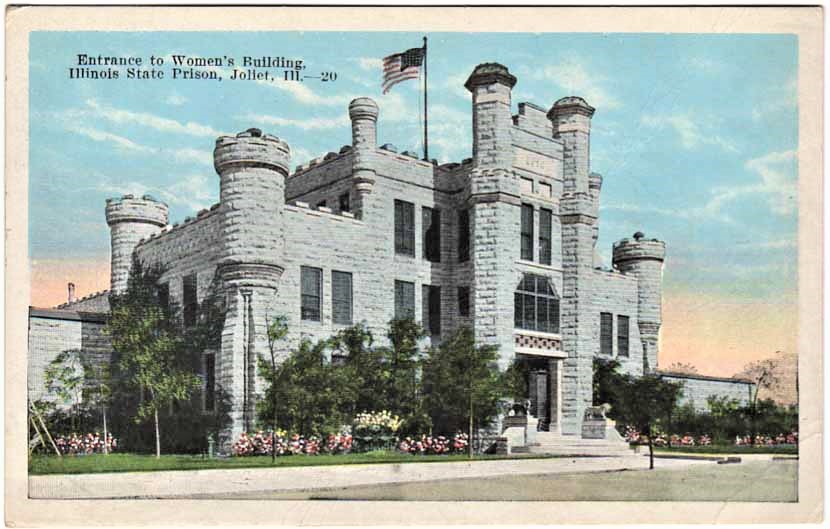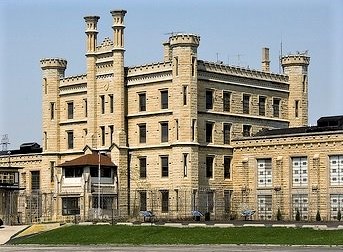Separate but not equal: women prisoners at Joliet

 By Sandy Vasko
By Sandy Vasko
One of the things that I notice about all the hoopla surrounding the old State Penitentiary on Collins Street is that, it’s all about the men who were incarcerated there. Rarely is a word said about the women who were also there, locked into a tower, only to be let out once or twice a year.
Let’s go back to the beginning: Sally Jefferson has the distinction of being the first woman sentenced to prison in the state in 1835. She was sent to Alton to serve her time among the men, but was pardoned 10 days later. In the early 1840s, several less-fortunate women were forced to serve out their entire one-year sentence at Alton. They were housed in the cookhouse during the day, and locked in the cellar at night.
In 1845, a prison inspector wrote to the governor to ask that a separate female prison be built to relieve the Alton warden of the demands of keeping the two sexes separate. In 1858, the first part of the Joliet Penitentiary built was the female section, consisting of 100 cells. It was still within the men’s prison, but had separate walls surrounding it. It was adjacent to the chapel, hospital and dining hall, so that access to these facilities could be private and discreet, away from the prying eyes of the men.
However, because of the rapidly growing male population, for the first five years, men were housed in these quarters and the women were housed in a room above the Warden’s office. The penitentiary commissioners reported, “The female convicts, owing to the crowded state, were all confined in one small room, which was made to serve a three-fold purpose of working, eating, and sleeping, rendering it alike inconvenient and unhealthy.”
No consideration was made for the special needs of the female prisoners, other than to assign a female matron to watch over them. Pregnancy was an ever-present and growing problem at Joliet.
In May of 1862, Warden Samuel Casey wrote the governor about 19-year-old Anna Roach who had been convicted of burglary in Kankakee. He described her as being “badly pregnant” and begged the governor to pardon her or tell him what to do about the situation.
Within weeks, she was pardoned and sent home. However, two weeks later, a courts’ official, C.T. Townsend, wrote to the governor demanding to know why she was still at large after her conviction. The fact that she was quite large apparently didn’t give him a clue.
Although many women sought a pardon and an early release, after 1870, most were forced to serve out their full sentences at Joliet. Their four-story quarters consisted of several dormitory sleeping rooms, along with sewing, laundry, and dining rooms. The women were never allowed outside except for a once-a-year stroll in the prison yard where they faced “whistles and cries from the locked in and eagerly watching male prisoners.
By 1890, severe overcrowding made conditions considerably worse. The Chicago Tribune painted a bleak picture: “For several years between 60 and 70 women have been crowded into a few small rooms on the top floor of the Warden’s house. Sanitary conditions in the room are bad. In the dormitory 25 cots are crowded into the space originally designed for 12. There are no windows in the cells, which are dark and poorly ventilated. The workrooms are small. The laundry and dining rooms are the same. One small room, not removed from the rest has served as the hospital. The conditions have menaced the health of both the inmates and the officers, and made the administration of discipline difficult.”
In June of 1895, the state legislature appropriated $75,000 for the building of a new female prison, which was completed in 1896. It is the building, which now stands across Collins Street from the original prison.
Writing in the summer of 1899, three years after her move to the new prison, Maggie Tiller, sentenced to 20 years for murder wrote, “I can look out of my window and see the beautiful trees and ordour is something grand from the grass.”
The women now had their own yard and allowed outdoor recreation three times a week. But their life was still harsh. Discipline remained strict, and a code of silence was enforced.
They worked nine-hour days, mainly doing laundry for the men’s prison. The smell of the chemicals used in the “modern laundry facility” permeated the entire prison as well as everything they wore. Matrons claimed that they laundered 50,000 pieces a month.
Again, quoting Tiller, “I don’t know of anything much to write, only lots of hard work, and plenty of sickness here now. The girls all seem to be out of order in some way or ‘nother. I guess they all want Liberty more than anything else.”
The original women’s prison, built as part of the larger prison on Collins Street. As male prisoners moved in, the women were relegated to a cramped, dirty room on the second floor.
The new women’s prison, built solely for them across Collins Street from the main prison.

